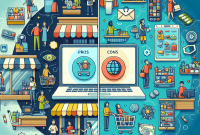
E-commerce Trends to Watch in 2021: What Consumers and Businesses Need to Know
Welcome to our in-depth analysis of the hottest E-commerce trends to watch in 2021. In this article, we will explore the key developments shaping the online retail landscape this year, and what they mean for both consumers and businesses. From emerging technologies to shifting consumer behaviors, we will cover it all. So, let’s dive in!
1. Rise of Social Commerce
Social commerce is on the rise, with platforms like Instagram and Facebook integrating shopping features directly into their interfaces. This trend allows consumers to discover and purchase products without leaving their favorite social media apps. Businesses are leveraging social commerce to reach new audiences and drive sales.
Example:
A clothing brand launching a new collection exclusively on Instagram, allowing customers to buy items through the platform’s integrated shopping functionality.
2. Personalization and AI
Personalization is key in E-commerce, and AI technology is enabling businesses to offer highly customized shopping experiences. From personalized product recommendations to AI-powered chatbots, companies are using data to tailor their offerings to individual preferences.
Case Study:
An online beauty retailer using AI algorithms to analyze customer data and provide personalized skincare recommendations based on individual skin types and concerns.
3. Sustainability and Ethical Shopping
Consumers are becoming increasingly conscious of the environmental and social impact of their purchases. As a result, there is a growing demand for sustainable and ethically sourced products. Businesses are responding by adopting eco-friendly practices and transparent supply chains.
Anecdotal Evidence:
A study showing that 70% of consumers are willing to pay a premium for products that are environmentally friendly and sustainably produced.
4. Mobile Shopping Dominance
Mobile commerce continues to dominate the E-commerce landscape, with more consumers using smartphones and tablets to make purchases. Businesses are optimizing their websites and apps for mobile users to provide a seamless shopping experience on smaller screens.
Statistic:
According to a recent report, mobile E-commerce sales are expected to account for 54% of total online sales by the end of 2021.
5. Contactless Payments and Digital Wallets
The COVID-19 pandemic has accelerated the adoption of contactless payment methods and digital wallets. Consumers are increasingly looking for safe and convenient ways to make transactions, leading businesses to offer a variety of payment options to accommodate these preferences.
Example:
A local restaurant implementing QR code payments for dine-in customers, allowing them to pay through their smartphones without physical contact.
6. Augmented Reality Shopping Experiences
Augmented reality (AR) technology is transforming how consumers shop online by allowing them to visualize products in real-world settings. Businesses are using AR to enhance the shopping experience and give customers a more immersive view of their products before making a purchase.
Case Study:
A furniture retailer offering an AR app that allows customers to see how a couch would look in their living room before buying it, increasing confidence in their purchase decision.
FAQs
Q: How can businesses stay ahead of E-commerce trends in 2021?
A: Businesses can stay ahead by keeping up-to-date with industry news, investing in the latest technologies, and listening to customer feedback to adapt their strategies accordingly.
Q: What should consumers look for when shopping online in 2021?
A: Consumers should look for secure payment options, transparent product information, and sustainable practices when shopping online to make informed purchasing decisions.
Conclusion
In conclusion, E-commerce trends in 2021 are shaping the way consumers shop and how businesses operate in the digital space. From social commerce to AI personalization, sustainability, and mobile dominance, these trends are reshaping the E-commerce landscape. By staying informed and embracing these trends, both consumers and businesses can thrive in the ever-evolving world of online retail.






